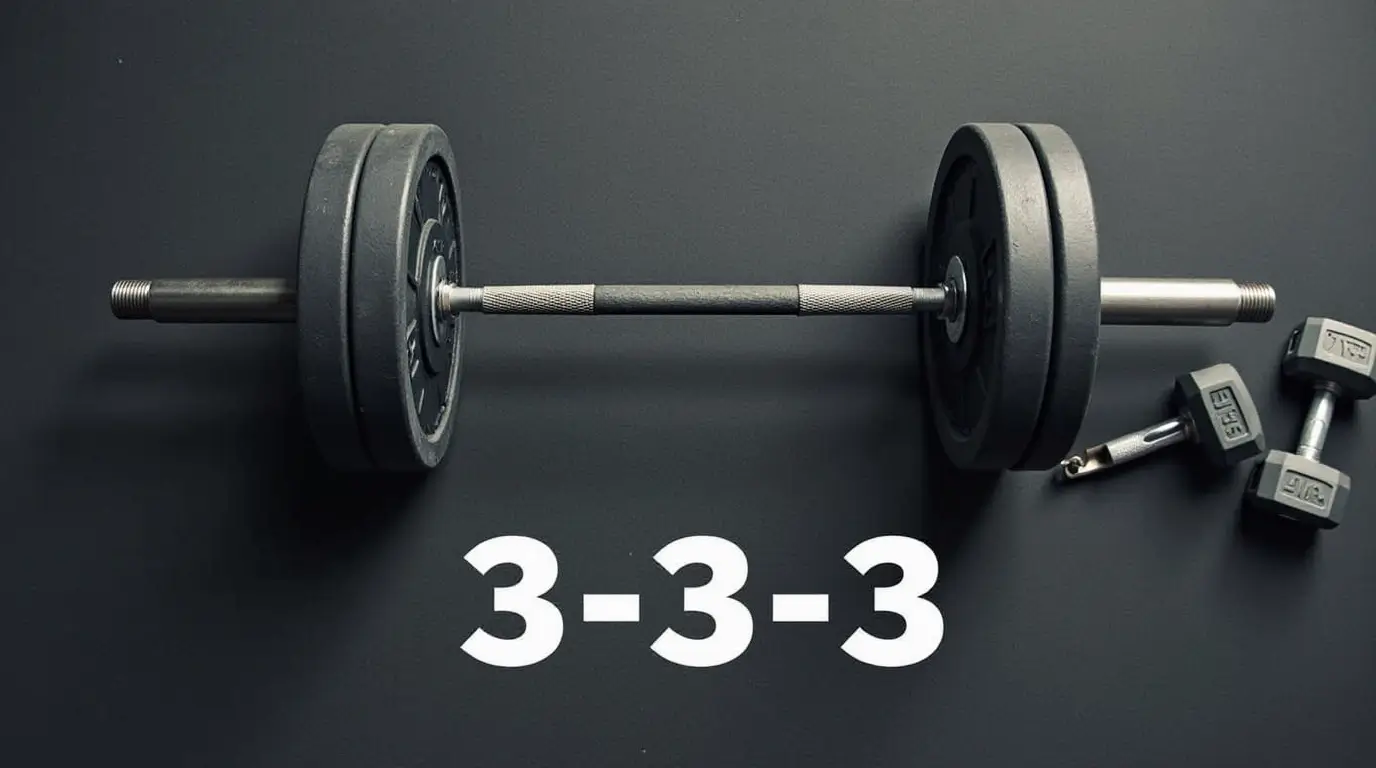If you’ve been struggling to see the results you’re hoping for at the gym, you’re not alone. Whether you’re looking to build strength, increase muscle mass, or simply get more out of your workout sessions, it can be frustrating when your routine feels like it’s not delivering. But what if there were a way to maximize your workout potential while keeping things simple and manageable? That’s where the 3-3-3 workout rule comes in.
The 3-3-3 rule is a straightforward approach to strength training that allows you to get the most out of your gym time without overwhelming yourself with complex routines. This method focuses on three key components: sets, repetitions, and exercises. It’s an efficient and effective way to build muscle and strength, and it doesn’t require hours of gym time to see results.
Whether you’re a beginner or a seasoned gym-goer, understanding the 3-3-3 workout rule can be a game-changer for your fitness goals. By following this simple structure, you can improve your workouts, make better use of your time, and achieve better results. In this article, we’ll break down the ins and outs of the 3-3-3 rule, its benefits, how to implement it, and common mistakes to avoid.
If you’re short on time but still want effective training, you might wonder: Is 30 minutes enough for a dumbbell leg workout? Find out here.
Table of Contents

Understanding the 3-3-3 Workout Rule
The 3-3-3 workout rule is designed to provide a balanced and efficient approach to strength training. It focuses on the following principles:
- 3 Sets: You perform 3 sets of each exercise.
- 3 Repetitions: Each set consists of 3 repetitions.
- 3 Exercises: You include 3 exercises in your workout session.
This structure might sound simple, but it’s incredibly effective in targeting muscle growth, increasing strength, and ensuring that you’re making the most of your workout routine. Instead of doing high repetitions or too many exercises that can cause exhaustion, this rule focuses on quality over quantity. With just three exercises, you can cover a wide range of muscle groups and still leave the gym feeling accomplished.
Looking for alternative chest exercises? Try a cable chest workout to target your pecs effectively.
The Structure of the 3-3-3 Rule
The beauty of the 3-3-3 rule lies in its simplicity. Each workout consists of three key components:
- Sets: The rule focuses on doing 3 sets per exercise, which is a balanced approach for muscle development.
- Repetitions: Each set consists of 3 repetitions, allowing you to lift heavier weights for fewer reps, which is ideal for building strength.
- Exercises: Only three exercises are performed per session, which means you can focus on quality and intensity rather than quantity.
By sticking to this simple formula, you’re giving yourself the space to focus on form, strength, and progression. Plus, it’s an easy-to-follow routine that doesn’t require constant adjustment.
Why Should You Use the 3-3-3 Rule?
Now that you understand what the 3-3-3 rule is, let’s dive into why it works so well and why you should consider using it in your gym routine. Here are some key benefits:
Efficiency and Time-Saving
In today’s busy world, it can be hard to find time for long workouts. The 3-3-3 workout rule is perfect for those who want to make the most out of their time at the gym. By sticking to just three exercises and focusing on low reps with high weights, you can complete an intense and effective workout in less time. You won’t have to worry about spending hours in the gym, which can be a huge advantage for people with tight schedules.
Build Strength and Muscle
One of the main goals of the 3-3-3 workout rule is to build strength and muscle. The low-rep, high-weight method is ideal for targeting your muscles more efficiently. Lifting heavier weights with fewer reps engages more muscle fibers and encourages your body to grow stronger over time. By focusing on compound movements, which target multiple muscle groups at once, you’re able to achieve more in less time.
Avoid Overtraining and Burnout
Another advantage of the 3-3-3 rule is that it helps you avoid overtraining. Many people make the mistake of doing too many sets or exercises, which can lead to exhaustion or injury. The 3-3-3 rule helps to keep things balanced. With only three exercises and a reasonable number of sets and reps, it prevents overworking your muscles while still pushing them to grow and get stronger. You’re less likely to burn out, which ensures consistent progress.
How to Structure Your Workouts Using the 3-3-3 Rule
The beauty of the 3-3-3 rule is how simple it is to implement. Here’s how you can structure your workout to get the most out of this approach.
Step 1: Choose Your Exercises
When selecting exercises, it’s important to focus on compound movements that target multiple muscle groups at once. This ensures that you’re working the most muscles possible and maximizing your time at the gym. Aim to include a mix of lower body, upper body, and core exercises to achieve a balanced workout.
Here are some great exercises to include in your 3-3-3 workout:
- Squats: These are excellent for building leg strength and engaging your core.
- Deadlifts: This compound movement targets your back, legs, and core muscles.
- Bench Press: A classic upper-body movement that works your chest, shoulders, and triceps.
- Pull-Ups: Great for targeting your back and biceps.
- Overhead Press: Perfect for building shoulder and tricep strength.
- Bent-Over Rows: This exercise works your upper back and shoulders.
These exercises are not only effective but also versatile, allowing you to hit multiple muscle groups without spending hours at the gym.
Step 2: Perform 3 Sets of Each Exercise
Once you’ve chosen your exercises, perform 3 sets of each one. A set refers to completing the prescribed number of repetitions (3 reps per set), and each set should be followed by a brief rest period. Keep rest times between 30 seconds to 1 minute to maintain intensity throughout your workout. You want to be able to recover enough to perform the next set with good form but not too long that your muscles cool down.
Step 3: Perform 3 Repetitions Per Set
In the 3-3-3 workout rule, each set consists of only 3 repetitions. This may seem like a small number, but the key is to lift heavy weights that challenge you. The goal is to push your muscles to their limits with each rep. If the last rep of your set doesn’t feel challenging, you may need to increase the weight. By keeping the reps low and the weights heavy, you’ll be able to engage more muscle fibers and stimulate growth and strength development.

Common Mistakes to Avoid When Following the 3-3-3 Rule
Even though the 3-3-3 rule is simple, there are still common mistakes people make that can hinder progress. Here are some of the most frequent errors to watch out for:
Mistake 1: Using Weights That Are Too Light
The 3-3-3 rule is all about lifting heavy weights, so it’s important not to use weights that are too light. If the weight doesn’t challenge you by the third repetition, you won’t see the results you’re hoping for. The key is to increase the weight gradually as you get stronger. Be sure to focus on form and control, as lifting too much too quickly can lead to injury.
Mistake 2: Skipping Rest Between Sets
Skipping rest between sets is a common mistake that can reduce the effectiveness of your workout. Rest is necessary for your muscles to recover and prepare for the next set. If you rush through sets without adequate rest, you may not perform at your best, and your muscles won’t get the recovery they need to grow. Stick to the 30-second to 1-minute rest period for optimal results.
Mistake 3: Not Varying Your Exercises
While the 3-3-3 rule is effective, it’s important to switch up your routine every few weeks to avoid hitting a plateau. Doing the same exercises continuously can cause your body to adapt, making it harder to make progress. Change up your exercises every few weeks to keep challenging your muscles and prevent stagnation. This could mean switching to different variations of the exercises or adding in new movements altogether.
FAQ About the 3-3-3 Rule Gym
What is the 3-3-3 workout rule?
The 3-3-3 workout rule involves doing 3 sets of 3 repetitions for each exercise. This approach focuses on strength and muscle growth through low-rep, high-weight training.
Is the 3-3-3 rule good for beginners?
This method is ideal for strength-focused individuals, but if you’re working on weight management, you may also want to explore structured programs like Concentra’s weight management program.
If endurance training is more your style, you might be curious about The Murph Challenge—a workout known for its intensity. Learn about it here.
Can I build muscle with the 3-3-3 rule?
Definitely. The 3-3-3 rule is great for muscle building, as the low-rep, high-weight structure is ideal for stimulating muscle growth. By progressively increasing the weight, you’ll continue to challenge your muscles and promote growth.
How long should I follow the 3-3-3 rule?
You can follow the 3-3-3 rule as long as it works for you. It’s a versatile structure that can be used for several months before switching up your routine to continue challenging your muscles.
Conclusion: Take Your Fitness Journey to the Next Level with the 3-3-3 Rule
Incorporating the 3-3-3 workout rule into your gym routine can help you achieve your fitness goals more effectively. Whether you’re looking to build strength, increase muscle mass, or simply optimize your gym time, this rule offers a simple yet powerful structure that you can rely on. By sticking to three sets, three reps, and three exercises, you’ll be able to stay focused and make consistent progress.
Ready to take your fitness journey to the next level? Try implementing the 3-3-3 workout rule into your routine and see how this simple structure can transform your results. Keep pushing yourself, stay consistent, and enjoy the progress you make along the way.

